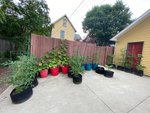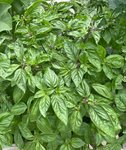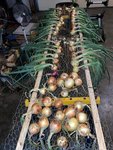






Community Growers of Montgomery County is offering a free garden walk to four backyard gardens in the westside neighborhoods of Crawfordsville. The walk takes place between 10 a.m. and 2 p.m. Saturday.
Participants are invited to do the entire walk to all four locations or visit individual gardens. Organizers ask participants to bring their own lunches. The group will eat lunch in Kathy Steele Park (located on West Main Street behind the Youth Service Bureau at 808 W. Pike St.). Community Growers of Montgomery County will transport your lunch for you.
This garden walk is not an ordinary “come and marvel” garden tour but rather a chance to see and learn how four gardening families with varied levels of experience have changed their city yards into native plant beds (pollinator gardens) and vegetable gardens. Participants will be able to observe and ask questions at each 30-minute stop. Each garden and gardener has a story to share. Signs will mark each of the locations and you may either walk or drive between gardens.
The tour begins at 10 a.m. at the Meeks/Walsh garden at 207 W. Main St. Tom Meeks will show his tomato trellising and talk about gardening on a budget. Meeks and his wife Heidi Walsh started gardening early in the pandemic with a newborn in tow.
The second stop is also on West Main Street. This segment begins at 11:05 a.m. and is located at newlyweds Nate Tompkins and Jackie McDermott’s home at 511 W. Main St. Tompkins is new to gardening. He will show visitors what he has in a small space, in pots, in other containers, and along a fence. The Tompkins/McDermott family property has limited sun and they will talk about how they work around that.
After visiting these two gardens, the group will head to Kathy Steele Park to eat lunch (11:45 a.m. to 12:15 p.m.).
After the noon break, the group will head to its third stop at Kathy and Jim Brown’s home at 912 W. Wabash Ave. If you wish to join in for the afternoon portion, join the group at the Browns’ garden at 12:25 p.m. On this property, Kathy, a longtime, small-space gardener, will show visitors her raised beds and how she over-winters vegetables in a small greenhouse/cold frame set up. Visitors will get to see what a large number of food varieties can be grown in a small space.
From West Wabash, the group will head to its fourth and final stop at 1418 W. Market St., the home of Dianne and Bill Combs. This stop begins at 1:15 p.m. Combs’ garden visitors will be able to see a yard nearly entirely converted into gardens.
She will show tour participants her greenhouse and how she is currently working to increase soft fruit and berry crops in the yard even as she continues to expand her collection of native pollinator plants. She grows many edibles too and often mingles vegetables among flowers.
The four gardening families on this first-ever Garden Walk sponsored by Community Growers of Montgomery County have various backgrounds and life experiences that have led them to care about putting a spade in the ground or a trowel in a pot.
Combs Garden
Dianne Combs has a mother who made sure her daughters knew where their food came from. As a little girl, she was entrusted with a little garden patch next to the back door of their house. She felt so important and learned young how plants, grow, bloom and fruit, and how they should be cared for. Dianne Combs has never looked back and has been gardening all her life, making sure that her three children had gardening experiences like she did.
Her big, south-facing yard-become-garden testifies to the soil and species health that home gardeners can bring into their own small patches of ground whether the gardens be in a container or two or in a space big enough for fruits and nuts and everything in between. She has been gardening in her current location since 2005.
Meeks-Walsh Garden
Meeks and Walsh love to cook. As new gardeners, they find it especially rewarding to walk out the back door to pick a sprig of rosemary or a tomato for a recipe for dinner. It has been a happy surprise to them to experience how gardening connects them with community members, family and friends alike. Most other differences simply disappear when people share tips about soil or plant species or shade planting. Gardeners commiserate about comical mistakes — “we thought a zucchini plant was an eggplant our first year,” notes Meeks — and all gardeners rue visits by squirrels and rabbits.
As a young family, Meeks and Walsh were first expecting and then welcoming a new baby just as the pandemic began. They found themselves at home, their work patterns either changed or evaporated. This meant their time together expanded: they resolved to try gardening. They built a garden box and began to explore growing tomatoes and peppers. At the Farmers’ Market which they visit “every single week,” they had begun to buy and use fresh and local vegetables. They also developed acquaintanceships with experienced gardeners that they could pepper with questions. They jumped in — and now are in their third year.
Their garden this year might well be called a “pasta garden” as it focuses on peppers, tomatoes, eggplants and herbs. See how various containers — from a five-gallon bucket to a large raised bed — can be used to start and house a garden.
“Now that we have adopted gardening as our [family] hobby, we look toward introducing new fruits and vegetables and maybe making compost,” Meeks said.
In the future, they plan to introduce more pollinator plants into the mix. Their son Henry is already well introduced to family gardening. Their special challenge this year is to learn better how to preserve harvests through canning and other preservation techniques.
Brown Garden
Brown has a job downtown that keeps her busy interacting with kids and adults and otherwise being in the public eye. For her, gardening is a respite, “a relaxing and productive way to wind down,” as she notes. Frown also finds it really satisfying to grow her own produce. She uses her vegetables fresh in the summer, of course, but also really appreciates pulling “bags of vegetables out of the freezer and know[ing] exactly where they came from” during the winter.
When the Browns bought their first home, Kathy Brown immediately tried some gardening though she first focused on roses and other perennial flowers. When the Browns moved to Crawfordsville in 2003, they built a few raised beds to grow vegetables. When their children were young and needed lots of backyard play space, they had little time to do “more than dabble.”
Once the children grew and swing sets and sandboxes disappeared, Kathy Brown began to expand and experiment with food plants. She currently grows a large variety of vegetables in a relatively small space. One of her big adventures in a little yard has been adding a cold frame. Because of this season extending space, last year they “were able to eat at least a little bit of fresh produce from early March all the way through early January.”
Brown encourages new gardeners to start small, have fun, don’t fear experimentation, “take good notes and expect to make mistakes.” Gardens and gardeners alike prosper by hands-on learning.
Tompkins-McDermott Garden
Both Jackie McDermott and her husband Nate Tompkins are transplants to the Midwest. Like their neighbors the Meeks/Walsh family three blocks up the street, they were glad to find some good Midwest dirt in their new backyard. They too began gardening during the spring of 2020.
The nature of their property doesn’t leave a lot of available ground for a standard garden so they got creative and put plants primarily in pots, in a couple of raised beds, and began experimenting with growing things vertically up their fence. The couple has planted lots of sunflowers and currently sport a fine vertical stand of them along a brick wall.
“We like to watch things grow, to see flowers in the yard, and support the pollinators,” Tompkins said.
They are excited about connecting with others growing locally through the garden walk. Visitors will enjoy and be impressed by the imaginative growing places this family provides for cucumbers, zucchini, eggplant and sunflowers.
Other items that may interest you
